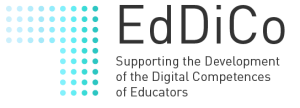In “training material 3 (TM3)” the focus is on tutoring international, intercultural and diverse learner groups, including the usage of digital Information and Communication Technology (ICT) tools at education institutions for Vocational Education and Training (VET) as well as Higher Education (HE).
As a basis for TM3 we referred to Smith (2005) with “Fifty-One competencies for Online Instruction” which then were increased to 72 competencies for online instruction and supplemented with competencies for intercultural teaching based on the literature that has been accumulated.
Furthermore, the identified competencies were summarized and put into categories to obtain a better overview. As a result, we were able to allocate the identified competencies to 5 categories: teaching skills, communication skills, technical skills, intercultural competence and commitment.
Training material on tutoring international, intercultural and diverse learner groups will consist of 20 to 30 hours of learning including theoretical references and presentations, as well as practical tasks for the trainees. Practical tasks will be based on group work and trainee collaboration in order to foster teacher, trainer and adult educator mutual collaboration and intercultural approach. International groups of teachers will be working on practical tasks in groups and teams.

